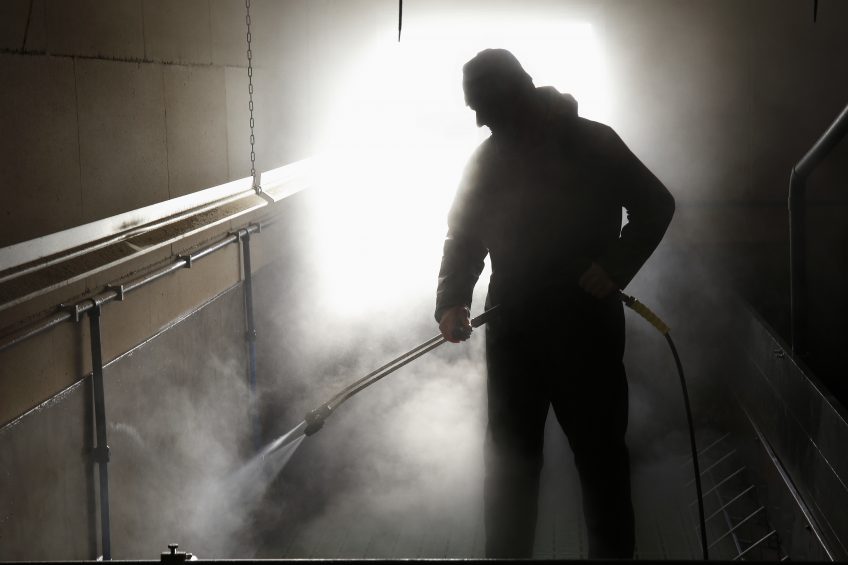Tools to aid pig producers with biosecurity and management

Biosecurity is not only a matter of disinfecting and fencing – above all it is a matter of mentality. Being aware of how pathogens can enter a farm can make pig producers more prudent about what to pay attention to. 2 new biosecurity tools can help in this respect.
When planning a control plan for a disease (i.e. Porcine Reproductive and Respiratory Syndrome – PRRS) it is essential to follow a systematic approach like the 5-step process. Step 1 and 2 – aim at setting the goals and expectations and determine the current status of the farm.
Step 3 – it is important to identify the constraints, namely the biosecurity and management risks that exist in farms or systems. Considering the information of the previous 3 steps it is possible to propose solutions in step 4 and finally, in step 5, solutions can be implemented and results can be monitored.
High level biosecurity
High level biosecurity is a must for farms located in pig dense areas, due to high infection pressure. Therefore, a lot of research projects have been dedicated to learn about the constraints that complicate the right implementation of disease control programmes; they intend to show how viruses i.e. PRRSv are shed from pigs and transmitted between farms. This has led to a common understanding for good external biosecurity, to avoid introduction of new viruses, with high focus on clean transports, separate and clean load out areas, and downtime for visitors etc.
A recent publication referring to farms in Belgium, France, Germany and Sweden documented that often external biosecurity is more important than internal biosecurity. This is probably not any different to farms in other countries and areas.
10 golden rules to control PRRS

Another recent publication reporting a regional PRRS eradication project, described 10 golden management rules that are crucial to support control of PRRS. The golden rules are user-friendly guidelines to help herd owners improve biosecurity on their farms. They are easy to understand, but can be challenging to follow, especially with increasing litter sizes. In each farm it is crucial that the veterinarian and farmer can discuss each management rule in detail, and give specific guidance on how it can be applied.
Location: Controlling the uncontrollableelement
Another important aspect that affects the likelihood of success in controlling certain diseases is location. However, it is difficult to change the location of a farm; therefore internal biosecurity, pig flow, and management become even more crucial in order to prevent internal transmission of pathogens like PRRS.
2 tools in identifying and visualising biosecurity constraints
Boehringer Ingelheim recently introduced 2 new tools that aim to help identify and visualise constraints related to external and internal biosecurity, pig flow, management and trace pathogen carrying agents.

The ‘Pathogen Tracing Kit’, or short ‘p-Track’.
With that, it will be possible to trace and monitor multiple risks associated with pathogen carrying agents in the farms: tools, farm staff, or visitors, or other fomites. Using the tool, veterinarians and farmers can measure in real time risky events related with movements (Figure 1). For example, when a certain object (a pushboard or an injector) is used in different areas of the farm it can be detected and quantified.
Figure 1 – p-Track traces and monitors multiple risks associated with pathogen carrying agents in the farms: tools, farm staff, or visitors, or other fomites.

In addition, the tool can measure relative position inside or outside buildings of critical persons and tools. This feature allows the areas of the farm with more risky events to be easily identified and monitored. In particular, one important biosecurity risk linked with new outbreaks, which is stepping outside the barn onto the dirty area of the loading dock, can be detected and corrected.

The ‘Combat’
Shortened from ‘Comprehensive Online Management and Biosecurity Assessment Tool’. It was developed to help farmers and veterinarians evaluate and improve the level of biosecurity, pig flow and management procedures.
Over the last 20 years different tools have been developed to assess and score internal and external biosecurity, like the Production Animal Disease Risk Assessment Program (Padrap – Iowa State University) or Biocheck (Ghent University). The key benefit of those scoring systems is not the score in itself; in fact they should facilitate behavioural changes that help improve pig flow and management, by visualising the risky behaviours and the transmission patterns of pathogens.
With this biosecurity tool, the evaluation of management procedures is unique in the detail of evaluation of management habits, the feedback format that allows farmers, veterinarians and other advisors to address and prioritise high risk procedures, and in the way it visualises the score (see Figure 2).
Figure 2 – Combat visualisation, 4-dimension bubble chart, indicating the internal risks (X-axis), external risks (Y-axis), risks related to location (bubble colour) and the quality of management and pig flow (size of the bubble).

The tool allows pig producers to evaluate areas for their own improvement and benchmark against other farms. The aim of the tool is to identify the most relevant parameters related to PRRS by highlighting them in order to start correcting the higher risk practices.
The difference between success and failure in risk reduction in relation to both biosecurity and management is not determined by the details in a scoring report. Improvements are only seen when constraints are understood, and a clear action plan to correct mistakes and risky behaviours is set and implemented.











